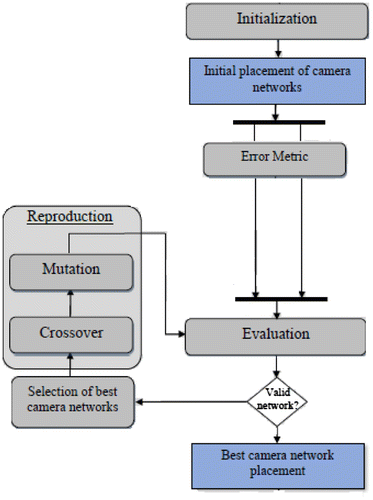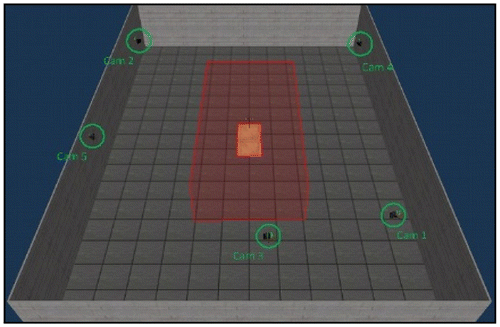 ?Mathematical formulae have been encoded as MathML and are displayed in this HTML version using MathJax in order to improve their display. Uncheck the box to turn MathJax off. This feature requires Javascript. Click on a formula to zoom.
?Mathematical formulae have been encoded as MathML and are displayed in this HTML version using MathJax in order to improve their display. Uncheck the box to turn MathJax off. This feature requires Javascript. Click on a formula to zoom.1. Introduction
Despite advances in motion capture systems, camera placement is still a challenging task, requiring expertise and experience, especially when the scene to acquire is complex and encumbered. In order to assist experimenters in this task, Aissaoui et al. (Citation2014) proposed to develop an algorithm-based optimization, which aims to find the optimal position of the cameras. The algorithm allows to find the tags arranged on a virtual humanoid, in the same place as the markers affixed on the real subject, and which simulates a neighbouring movement of the movement to be studied. Since then, this algorithm has been developed, as described in Aissaoui et al. (Citation2017). In continuity, 2 questions arise: (1) Can we reduce the number of cameras, despite the presence of an obstacle, without reducing the calibrated volume? (2) Can we increase the volume calibrated with the same number of cameras, which would be better positioned? The objective of this paper is to shed light on these questions through the application of the developed algorithm.
2. Method
To examine the relevance of a cameras configuration, the acquisition volume (Vacq) is calculated. In order to calculate Vacq, the working volume in which the subjects are free to move is represented by a set of tags (markers), and the visibility of each of these tags is calculated. For a tag to be reconstructed, it must be perceived by at least 2 cameras. Vacq is calculated as follows:(1)
(1)
Nt is the number of tags perceived by at least 2 cameras, and N is the total number of tags present in the working volume (N = 612).
Six cameras are used as the basic configuration for the digital experimentation. The cameras are initially placed on both sides of a room of 18 × 12 × 3 m (3 cameras on the right and 3 on the left, symmetrically) in order to perceive a working volume of 8 × 4 × 3 m in which is positioned, at its center an obstacle of 1 × 1 × 1 m. A camera has a field of view of 80º and an effective range of 8 m. These values were used to determine the visibility of a tag by a single camera. The triangulation is based on the visibility of the tag by at least 2 cameras. Starting from the basic configuration, the number of cameras is reduced to 5. The acquisition volume is calculated without and with optimization of the location of the 5 cameras. Then, using the basic configuration (without reducing the number of cameras), the acquisition volume is calculated without and with optimization of the location of the cameras. To optimize the location of the cameras, the GGA method of Aissaoui et al. (Citation2017) is applied (Figure ).
Figure 1. Diagram of GGA method to optimize the placement of cameras for motion capture (Aissaoui et al. Citation2017).

3. Results and discussion
The working volume is represented by 612 tags. With the basic configuration, the number of tags visible by at least 2 cameras is 524 tags, so:
3.1. 1st question
Each camera is eliminated one after the other without changing the location of the other cameras. Vacq is calculated for the 6 possibilities.
| • | Cam 1: Vacq = (423/612) * 100 = 69.12% | ||||
| • | Cam 2: Vacq = (446/612) * 100 = 72.87% | ||||
| • | Cam 3: Vacq = (398/612) * 100 = 65.03% | ||||
| • | Cam 4: Vacq = (400/612) * 100 = 65.36% | ||||
| • | Cam 5: Vacq = (443/612) * 100 = 72.38% | ||||
| • | Cam 6: Vacq = (422/612) * 100 = 68.95% | ||||
By reducing the number of cameras to 5 with optimization of their location, the number of tags perceived by at least 2 cameras is 509 tags, thus:
Without optimization, markers are lost when switching from 6 to 5 cameras. The maximum value of Vacq is 72.875% for 5 cameras. The minimal loss of tags is therefore 12.745%.
With optimization, markers are always lost when switching from 6 to 5 cameras, but this loss is minimized. Comparatively, with optimization loss of markers, following the switch from 6 to 5 cameras is equal to 2.45%. The minimal gain obtained by the optimization is 10.353%.
Figure shows the final configuration after reduction the number of cameras and optimization their location.
3.2. 2nd question
Starting from the basic configuration with 6 cameras, after optimization, the number of tags perceived by at least 2 cameras is 524 tags, thus:
Thus, with the same number of cameras (6 here) and an obstacle, the perceived volume, therefore assumed to be calibrated, increased with the optimization of the position of the cameras. The gain is 5.23% (90.85–85.62).
4. Conclusion
The results show that the minimization of the number of cameras, with the developed algorithm, can lead to substantial performance gains over the a priori placement.
Future work will aim at moving to the experimental stage and testing the results obtained by simulation.
Funding
This research was supported by the Franco-Algerian cooperation program PHC TASSILI [12MDU876].
References
- Aissaoui A, Baarir Z, Ouafi A, Pudlo P, Taleb-Ahmed A, Gillet C, Deraz F. 2014. Optimisation technique of camera placement for motion capture simulations. Comput Methods Biomech Biomed Eng. 17(Suppl 1):122–123.10.1080/10255842.2014.931517
- Aissaoui A, Ouafi A, Pudlo P, Gillet C, Baarir Z, Taleb-ahmed A. 2017. Designing a camera placement assistance system for human motion capture based on a guided genetic algorithm. Virtual Reality. doi:10.1007/s10055-017-0310-7.

